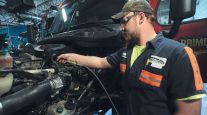Adoption of FA-4 Engine Oils Has Been Slow, but Early Tests May Point to Future Acceptance
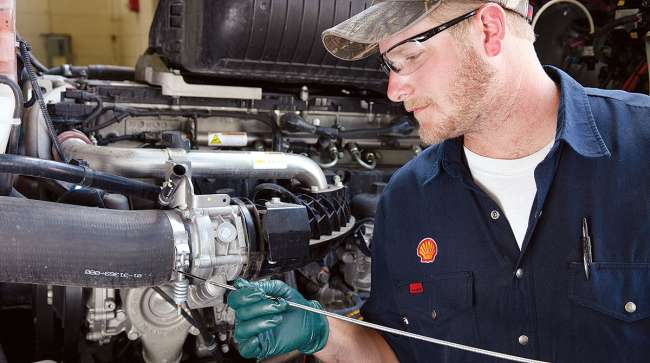
The American Petroleum Institute’s latest heavy-duty engine oil standards, designated CK-4 and FA-4, have been on the market for more than two years, but only one of these two new categories has seen significant adoption thus far.
CK-4 lubricants, available in the popular viscosity ratings that have evolved over the years for heavy duty, have by and large replaced the previous CJ-4 formulation.
But FA-4 engine oils, which are designed specifically to boost the efficiency of the latest generation of diesel engines and have limited backward compatibility, have been slower to gain acceptance from fleets. That may change, however, as the industry’s push toward greater fuel economy continues.
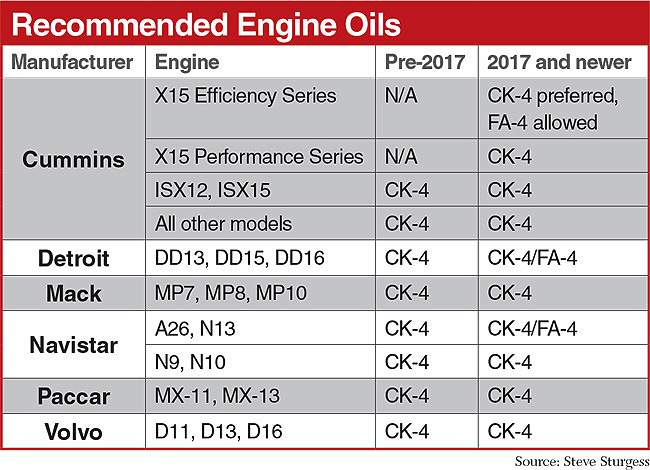
As a grade, 10W-30 oils under the prior CJ-4 standard also were slow to catch on initially until engine approvals moved mainstream.
But now many major fleets are reaping the fuel economy benefits of moving from 15W-40 to the lower viscosity 10W-30, and, with the added wear protection built into the latest CK-4 formulations, are seeing additional performance and durability, and in many cases extended oil drains.
And today, some fleets are looking to go a step further.
NFI, for one, is seeking to push the envelope on fuel economy by leapfrogging CK-4 and implementing FA-4 in new trucks entering its fleet.
“All our new vehicles are being delivered with the FA-4 formulation,” said Frank Trzaska, director of maintenance support at NFI. “In the majority of our shops, when FA-4 was first released, we’d run it out through the first change interval and then we’d change it out for the CK-4. Any delay has been caused by engine manufacturers giving approvals to use.”
Trzaska is taking advantage of NFI’s relatively quick equipment replacement cycles.
“We’ve been renewing the fleet for a number of years and 2015s are nearly all gone,” he said.
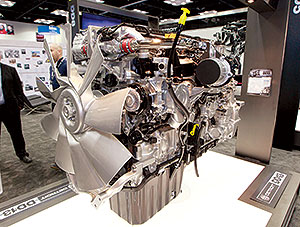
Detroit factory fills its new DD13, DD15 and DD16 heavy-duty engines with FA-4 engine oil. (John Sommers II for Transport Topics)
All remaining trucks are later models, most of which are fully FA-4 compatible. Trzaska has built a strategy that protects the fleet’s 2016 and earlier models while the company introduces FA-4 lubricant terminal by terminal.
“With FA-4, in the earlier days, we’d consolidate the newer trucks at a terminal with similar aged vehicles. What we did was change over one facility where we can run as a test without risk of compromising an earlier truck. We did a lot of oil sampling,” he said.
NFI, based in Cherry Hill, N.J., ranks No. 17 on the Transport Topics Top 100 list of the largest for-hire carriers in North America.
Because of its incompatibility with older trucks, FA-4 is proving to be a much more difficult-to-swallow pill than CK-4 for many fleets.
That challenge has held down early deliveries of the product, a situation that was not unanticipated by the lube oil industry, said Dan Arcy, OEM technical manager at Shell Global Solutions.
“We’ve been selling product through distributors and that’s about it,” Arcy said. “We kind of figured it was going to be a slow uptake. The reason I say that is I look back at the 10W-30 launch. It wasn’t really much of a switch going to 10W-30 [from 15W-40], which became pretty much a standard for factory fill in 2013. We’re only just now seeing 10W-30s take off. We had the first adopters and it was slow increases and volumes, but last year we saw a bunch of orders.”
Arcy said Shell anticipates much the same market response for its Rotella FA-4 lubricant as fleets rotate older equipment out.
Phillips 66 also expects the adoption of FA-4 oils to reflect a cautious approach by fleet owners and operators toward the new technology, said Tony Negri, commercial products manager. “Early adopters are experimenting, but broader sales will take several more years to develop until there is more equipment that requires this advanced formulation.”
Negri stressed that some OEMs have made FA-4 “an option, not a mandate, for 2017 models, and back-serviceability [for pre-’17 engines] is still being evaluated by most of the engine builders.”
While Detroit is factory-filling with FA-4 oils, other OEMs have been slower to adopt, said Rommel Atienza, commercial brand manager for Chevron. “Currently, most OEMs still factory-fill with CK-4 oils — mainly SAE 10W-30 — but we anticipate that changing as OEMs, lubricant marketers and customers become aware of the benefits of FA-4 oils. For mixed fleets, CK-4 still seems to be the best fit.”
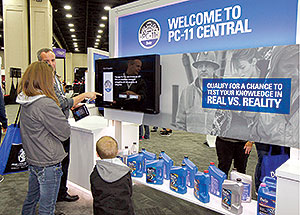
A trade show attendee learns about new engine oil categories at Chevron Delo’s booth. (John Sommers II for Transport Topics)
FA-4 oils have been designed specifically for some 2017 on-highway engines, said Brian Humphrey, OEM technical liaison for Petro-Canada Lubricants. He expects the uptake for FA-4 to rise year by year “as fleet owners see the potential cost benefits they can achieve and OEMs design improved engines to meet [emission] standards.”
FA-4 is compatible with or even factory-fill on truck engines manufactured since 2017, said James Nachtman, on-highway product marketing director at Navistar.
Nachtman said Navistar has verified the FA-4 oil provides about 0.7% better fuel economy in over-the-road applications for its International A26 engine.
“If the customer uses an oil sampling program and the customer shares those results with International, the FA-4 oil can help extend oil drain intervals longer than the published 50,000-mile interval for applications getting better than 6.5 mpg,” he said.
In some cases the FA-4 oil can enable fleets to run up to 70,000-mile oil drain intervals, Nachtman said, which is 40% longer than the standard interval.
“We do have customers doing that today and we have published information answering all the common questions such as how you do the sampling, what needs to be looked for and so on,” he said.
Looking ahead, the next stage of tighter federal greenhouse-gas emission standards in 2021 will create incentives for OEMs to consider moving to FA-4 as a standard factory fill, which could hasten acceptance of the FA-4 grade, Nachtman added.
For now, though, new trucks must coexist alongside 2016, 2015 and earlier models that are awaiting their turn in the replacement cycle. In those cases, fleets interested in using FA-4 oils would need to handle two different lubricants in their maintenance shops, a challenge that is hampering adoption.
Not surprisingly, most of the proponents of FA-4 are leaders in the industry’s push for greater fleet fuel economy.
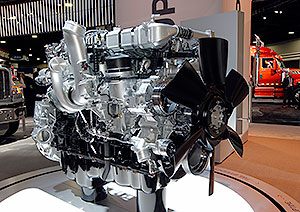
Navistar says FA-4 lubricant boosts fuel economy in over-the-road applications for its International A26 engine. (John Sommers II for Transport Topics)
Nussbaum Transportation, which participated in the North American Council for Freight Efficiency’s Run on Less demonstration in 2017, has transitioned to FA-4, but only recently.
Ploger Transportation also participates in public fuel economy demonstrations and is in the process of adopting FA-4 across its fleet.
Joel Morrow, the fleet’s director of research and development, said having two lube barrels is one of his concerns at the moment.
“We’re updating the fleet and we should be rotating mostly older trucks out to where we can go to a single source and not have to run two different lubes. It never, ever goes well,” he said. “That’s been one of our biggest concerns. We figured we’re going to kill two birds with one stone: We’re going to watch to see if there are any emissions or durability issues and we’re turning the fleet over to where we’re more streamlined. And where we’re on one lube source instead of two.”
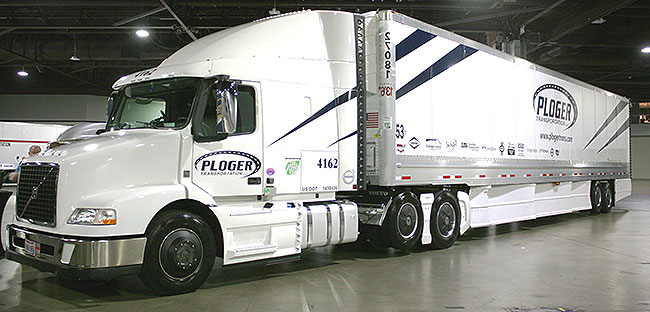
Ploger Transportation is among the early adopters of FA-4 engine oils, which are designed to boost the efficiency of late-model engines. (Steve Sturgess)
Demonstrating some big-fleet muscle, NFI took the two-barrel issue to several oil companies at the spring meeting of the Technology & Maintenance Council.
“We sat with Chevron, Shell, and said we don’t like this two-oil thing; we want to run just one and we want the better of the two, CK-4 or FA-4,” Trzaska said.
“Chevron right away came back and said we’ll give you a million-dollar policy that you’ll never have an FA oil failure in a 2017, 2018, 2019. Kind of left me stumped. Wasn’t the answer I was expecting,” he said wryly.
Trzaska said NFI has seen improved fuel economy and enhanced engine protection with no engine wear indicators.
“We haven’t really extended drains out; we’re staying with what the manufacturer suggests,” he said. “That is going to be the next step with our testing. We’re being a little conservative in our home-grown testing.”
But he sees nothing but positives: “So far it’s been unbelievably successful.”



